Nutritional Basics
Rather than simply saying that ‘food’ is one of our basic needs, let me be more specific and say that ‘obtaining nutrition’ is one of our basic needs. The purpose of consuming food is to satisfy two basic needs: 1. Energy or calories and, 2. Intake of nutrients, i.e., vitamins, minerals, etc. food must not only provide both but in the appropriate proportions as well.
Although it is beyond the score of this page to cover the nutritional requirements of each animal, I hope this page will give you a fair idea of what an animal needs and how it can be provided.
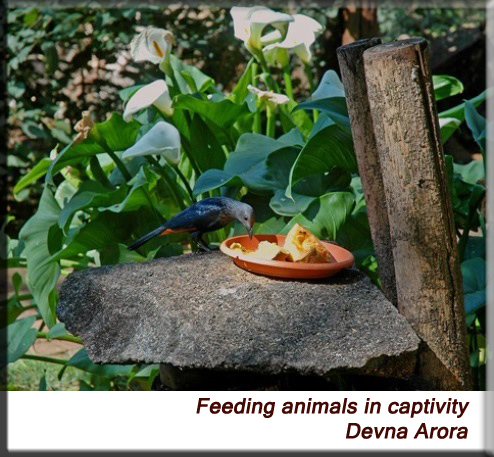
Let’s first have a quick look at the nutrients in food
Nutrients may be broadly classified into calorific energy and vitamins and minerals, both of which are equally vital for good health.
Carbohydrates are the simplest form of expendable energy. It includes sugars, starches, cellulose, and is a primary source of energy
Proteins are the fundamental components of all living cells and are essential for growth and repair of tissue. They are major components of muscles, ligaments, and tendons, and also include enzymes, hormones and antibodies that are essential for an organism to function appropriately.
Lipids are a source of stored energy and together with carbohydrates and proteins constitute the principal structural material of living cells. It is insoluble in water and includes fatty acids, oils, waxes, sterols and triglycerides.
Vitamins are organic compounds found naturally in foods obtained from animals and plants. They are required by the body in minute amounts and are essential for the growth and maintenance of the body’s activities.
Minerals are naturally occurring, inorganic substances essential in trace amounts for the proper functioning of the body’s activities.
Water is the most important nutrient of all! Water comprises the bulk of any animal’s body and is imperative for the execution of its various life processes. Although most animals ingest considerable amounts of water though their food, water is continually lost through processes like expiration, digestion, micturition, etc. and must be replenished. Fresh, clean and accessible drinking water must therefore be available for all animals at all times.
The amounts of nutrients required vary not only in accordance with the species but also according to the animal’s body condition, growth requirements, energy expenditure, and pregnancy status, if at all. Growing youngsters and gravid females have higher nutritional requirements both in terms of calories as well vitamins and minerals. Diets may also vary as per the seasons, or rather, by the additional demands of the seasons like winter, migrations, preparation for hibernation, etc.
While mammals and reptiles are largely divided into Herbivorous, Carnivorous or Omnivorous, birds are commonly divided into Carnivorous, Frugivorous, Granivorous, Piscivorous, Insectivorous, Molluscivorous, Mucivorous and Nectivorous. Although classified into broad groups, most animals are opportunistic in nature and given the opportunity, may consume a mixed diet. Eating habits may further be divided into generalist feeders, for example, squirrels, or specialist feeders, for example, koala bears and giant pandas.
Generalist feeders are often easier to accommodate as they are flexible in the dietary requirements and easily thrive on a variety of suitable foods. Specialist feeders require additional efforts to accommodate as they have very specific dietary requirements and may not accept or benefit from other foods.
Nutrition for baby animals
Let’s look at the needs of baby animals of each of the following categories:
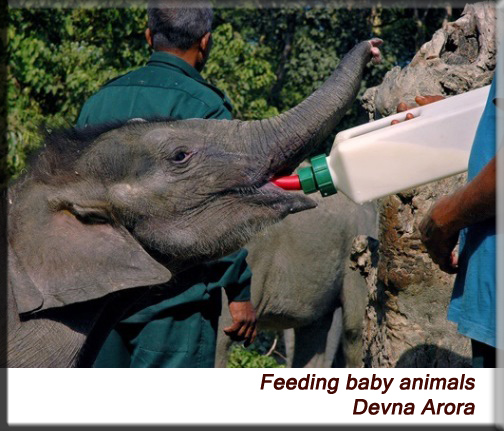
Baby mammals
The one thing all baby mammals have in common is that all only feed on their mother’s milk in the first stage of their lives, i.e. until they are weaned. Weaning period differs amongst species and can vary for a few weeks to a few years – this is often directly proportionate to the lifecycle of the species. Although it may seem that any baby animal can simply be bottled-fed packaged milk, this is in fact not true.
Let’s have a look at a baby mammal’s milk requirements and why infant formulas are inappropriate for them.
1. Colostrum – Colostrum is the first milk produced by the mammary glands at the time of parturition and precedes the production of true milk. It is not only a highly concentrated source of energy but also contains a boost of maternal immunoglobulins that are essential for building the immunity of baby animals. Infants that have been deprived of colostrum – esp. baby mammals rescued as newborns, are even more susceptible to various infections. They require extremely high levels of hygiene and caution for the first few weeks of their life, until they have developed their own immunity. Suitable replacers are currently available for the new born of some species.
2. Milk – Milk is an ideal source of energy, calcium and protein for the growth and development of baby mammals. Although all baby mammals have milk, the composition of milk may vary immensely between the milk of different species. Seal milk, for example, is extremely high in fats with up to 70% of dry matter, 30% of water and nearly 60% of milk comprising of fats. Rhino milk on the other hand is extremely high in water with over 90% of water, barely 10% of dry matter and only a negligible trace of fats.
The specific needs of baby mammals can vary greatly and ‘their mother’s milk’ is designed to suit and fulfill these needs. These needs are dictated by the growth and development process of the baby mammal, the species biology – foraging and ranging conditions of the parents, and the environmental conditions. What is also most important to remember is that the digestive system of baby animals is designed to digest and benefit from ‘that’ feed.
3. Formula – It is important to keep the composition of the mother’s milk in mind when formulating an appropriate formula. Although deficient formulas may be readily accepted by babies and they might not necessarily do them harm, adequate growth and development can only be achieved through wholesome and well-balanced (as per the species) formulas. The fats, sugars and water content must be balanced appropriately to obtain maximum benefits for the babies.
4. Lactose – The most common milk substitute that people are tempted to use for orphan babies is cow’s milk – this is highly dangerous and often fatal for babies. Cow’s milk contains high amounts of lactose which is not easy to digest by most other species. Formula milk (containing evaporated milk powder), is only comparatively easier to digest than fresh cow’s milk. The addition of probiotics and other digestive enzymes can be vital in the formulation of a digestible formula.
Simple feeding suggestions: Egg yolk is an excellent choice to both thicken and increase the nutritive value of milk. Although raw eggs are best avoided due to the of salmonella, boiled egg yolks can be safety given to most species; and given in higher quantities to species requiring high amounts of fat. Baby infant cereals like Nestum, Cerelac or Farex too can be added to infant formulas in small quantities.
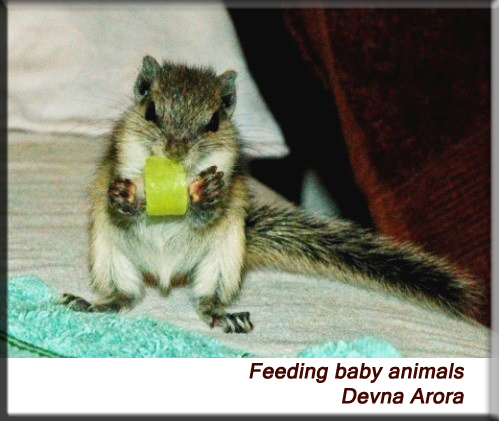
Once weaned off milk and formulas, most young animals consume diets similar to those of the adults.
For more information on types of feeders for baby aanimals, please refer to
Examples of feeders.
Baby birds
Although adult birds can differ significantly in their diet requirements, all baby birds have one thing in common – the requirement of protein for growth. Even species that feed exclusively on vegetative matter (grains, fruits, etc.) may feed their young exclusively on animal matter like caterpillars, spiders and other insects, etc. when the chicks are young. Although commercial formulations are available in most developed countries, feed formulas for other species will have to be made as per the need.
Simple feeding suggestions: Feeding babies of carnivorous birds is easy – they all require animal matter and this is commonly given in the form of chicken, meat or mice. Babies of insectivorous birds can be on beetles, grubs, grasshoppers and even chopped chicken or mice. Protein can simply be given in the form of egg, caviar, caterpillars and other grubs when feeding other species. Species like pigeons and parakeets that are not known to consume animal materials can safely be given egg; but they can also be given protein in the form of various nut butters, for example, sesame.
Unlike mammals, milk is in no way a part of any bird’s diet and it must never be given to birds. Although birds may digest miniscule amounts of milk and milk-based products, they are nest avoided.
For more information on types of feeders for baby aanimals, please refer to
Examples of feeders.
Baby reptiles
Baby reptiles too have their own specific diet requirements and they remain fairly constant from birth to adulthood. Enrichment for baby reptiles begins at birth and they may simply be kept in suitable enclosures with access to appropriate foods and water.
Feed
Feed must fulfill three crucial factors: It must be nutritious, palatable and easily digestible. In addition to the above, feed must always be hygienically prepared, stored and offered. All feeding equipment and water bowls must be thoroughly cleaned, disinfected and sterilized before use.
Frequency of feeds
While new born and weak babies may require to be fed round-the-clock, older babies only require feeds at regular intervals throughout the day.
Quantity of feed
As a general rule of thumb, a baby mammal requires 10-20% of body weight in feed every day. The precise amount of feed will vary accordingly to the density and nutritional value of the feed and it best to follow the feeding guidelines for the species in concern. Liquid feed quantities – rehydration solutions or formula, must always be limited to 3-5% of body weight per feed.
A growing youngster’s diet changes constantly and depending on the stage of growth may sometimes even double within a week. It is often difficult to envisage the exact proportion of increase desired per feed. Growing youngsters must hence always be offered a little more than what they consume in one sitting. Animals, by and large know how much their body needs and stop feeding once they have consumed an adequate amount.
Nutrition for adult animals
Although the needs of young animals may change frequently and vary through the stages of growth, the requirements of adult animals remain fairly constant. The best way to decide what to feed a wild animal is to offer it foods it would naturally consume in the wild. Since, this is often difficult to accomplish in captivity, captive animals are offered a combination of cultivated and wild gathered foods. It is also a good idea to provide salt licks, especially if their diet isn’t being supplemented with vitamins and minerals.
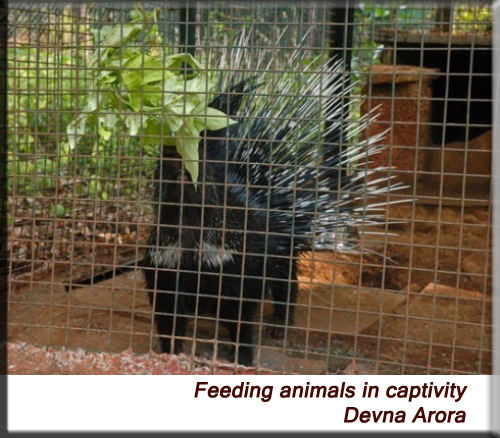
Although animals in captivity, due to lower energy expenditure rates, may be slightly chubbier than their conspecifics in the wild, they must never be allowed to become obese. Obesity will not only hamper the rehabilitation programme as the animal will be in sub-optimal body condition but also result in numerous ailments for both captive and wild animals like. If activity levels can somehow not be increased, food quality and quantities must be consciously controlled.
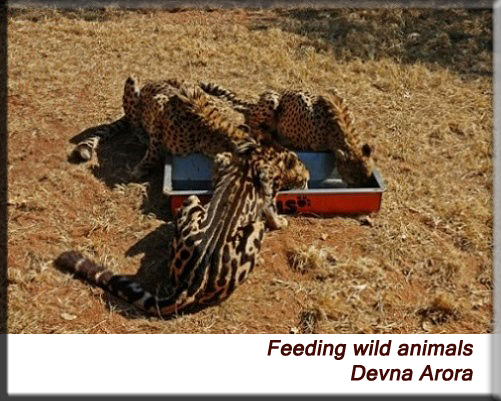
Water
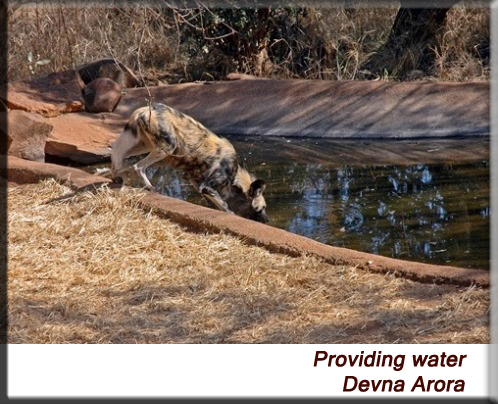
Water is one of our most basic needs and every animal must have access to fresh, clean drinking water. Water in play ponds and water baths must also be clean to prevent any diseases or skin infections. Water borne diseases are common where hygiene practices are poor and there is no excuse for bringing them upon anyone. Animals CANNOT DISTINGUISH between drinking and playing water – they will inevitably swallow both.
The water in play ponds and water baths must be drained and refilled regularly and they must all be periodically cleaned and scrubbed on the insides. Concrete basins also accumulate algae over time – this must be scrubbed clean. Every play pond or bath must have suitable drainage systems to facilitate this process.
Feeding enrichment
Feeding or consumption of food is prerequisite for survival and a significant component of any organism’s time expenditure. An animal’s body condition, health, growth and reproductive status would, under most normal circumstances, be directly proportionate to the nutrients consumed. Since nothing is readily available to them, all wild animals spend significant amounts of both time and energy in obtaining food. They also need skills and intelligence for the same, both of which will only develop once given the opportunity to explore and accomplish tasks themselves. This is a vital component of rehabilitation and important in keeping captive animals engaged.
Animals that have nothing to do become dull and lethargic and are often depressed. They are also more likely to show stereotypic behaviors like pacing, head shaking, etc. and such animals are also more responsive (can be both in positive or undesirable ways) to human beings simply because that is the only stimulus they are ever exposed to.
Feeding, environmental and behavioral enrichment are vital not only during rehab but also for an animal’s mental health.
Feeding enrichment can be provided in many simple ways:
• Offering whole foods where the animals need to shell or skin it themselves.
• Younger or smaller animals may be given whole foods with small slits, cracks or small amounts of peeled skin to help them begin and accomplish the task themselves.
• Scattering food around the enclosure whereby an animal spends considerable amount of time searching of it – the reward being the food itself.
• Hanging food in different places for arboreal species.
• Burrowing food for those animals that burrow and dig out roots.
• Keeping treats (tempting or more desirable foods) just slightly out of reach to encourage the animal to spend more energy in pursuing it – this encourages constructive brain activity and the building of skills.
• Offering appropriate live prey where legally permissible – this is vital for rehab.
• Offering a variety of foods – no human being or animal likes to eat the same thing day in and day out – we all need a change. This is not only for a change in taste but also ensures the intake of various nutrients. Animals too must be given foods in a rotation so they can be joyous to see the food offered and relish what has been given to them.
• Feeding at different times of the day also helps in preventing the animal from falling into a monotonous routine. Ensure there are some tidbits lying about if you want to play with the feeding timings though – no animal must ever be made to starve in the process.
N.B. All food must not be offered by means of enrichment if the animal is weak or unwell – such animals are better provided food in easily obtainable ways until their health picks up.
Below is a simple example of feeding enrichment:
I scattered some seeds and nuts on different branches and perches and you can yourself see the joy on this little parakeet’s face when he found something he wasn’t expecting and the satisfaction in consuming the same.
Useful links
BIAZA (2009) Zoo Research Guidelines: Nutrition and Diet Evaluation
http://www.biaza.org.uk/uploads/Committees/RC/Research%20
Guidelines/NutritionandDietEvaluation.pdf
Cornell University (2010) Nutrient content of milk varieties
http://milkfacts.info/Nutrition%20Facts/Nutrient%20Content.htm
Dierenfeld, E.S. (1996) Nutritional Wisdom: Adding the Science to the Art
http://www.nagonline.net/Articles/ZooBiology/nutrition%20issue/
Foreward1.pdf
Diereweld, E.S. (1997) Symposium on ‘Nutrition of wild and captive wild animals’
http://journals.cambridge.org/download.php?file=%2FPNS%2FPNS56_03%2FS0029665197000578
a.pdf&code=f9a47b94cf5ab9e38a9e7b504bdd5319
Du Preez, H. (2006) Balanced diet across the ages
http://www.naturalnutrition.co.za/wp-content/uploads/2011/04/Balanced-diet-accross-the-ages.pdf
EZNC (undated) Feeding guidelines
http://www.eznc.org/PrimoSite/show.do?ctx=7795,21671&anav=21550#21699
Nutrition Advisory Group (2002) Feeding Program Guidelines for AZA institutions
http://nagonline.net/Feeding%20Guidelines/feeding_guidelines.htm
Oftedal, O.T. and Allen, M.E. (1996) Nutrition as a Major Facet of Reptile Conservation
http://www.nagonline.net/Articles/ZooBiology/nutrition%20issue/
Reptiles1.pdf
Parsons, H. (undated) Balancing the protein content within a bird’s diet
http://www.awrc.org.au/uploads/5/8/6/6/5866843/nwcc-parsons-040724.pdf
The Merk Veterinary Manual (2011) Nutrition: Exotic and Zoo animals
http://www.merckvetmanual.com/mvm/index.jsp?cfile=htm/bc/toc_182400.htm
Warrington,P. (2001) Animal weights and their food and water requirements
http://www.env.gov.bc.ca/wat/wq/reference/foodandwater.html
Wattiaux, M.A. (undated) Milk composition and nutritional value
http://babcock.wisc.edu/sites/default/files/de/en/de_19.en.pdf
WildAgain Wildlife Rehabilitation (2002) Mammal Nutrition
http://www.ewildagain.org/Nutrition/nutrition.htm
Wildon, A. and Kleyn, R. (undated) The Nutritionist’s Role in the Management and Care of Captive Wild Animals
http://www.spesfeed.co.za/The_Nutritionists_Role_in_the_Management
_and_Care.pdf





